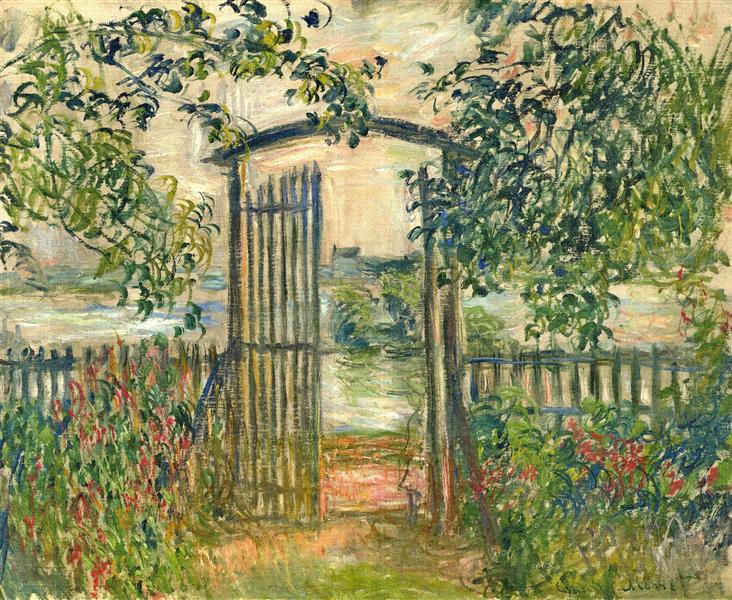Beschreibung
Claude Monet's "The Gate of the Garden at Vetheuil" (1881) is a masterful example of the Impressionist style, which captures the luminous and ephemeral essence of the landscape. Monet, one of the founders of this artistic movement, dedicated himself to capturing nature and changes in light and color through his loose brushstroke technique and innovative use of the palette. In this painting, the master paints with a particular focus on a singular scene: a private garden, evoking the intimacy and tranquility of French rural life.
The title of the work leads us directly to its subject: the garden gate, a symbolic element that represents the entrance to privacy and refuge in the natural realm. Composed with careful attention to detail, the gate is placed in the foreground, inviting the viewer to enter a world of greenery and light. The dark wooden structure of the gate contrasts with the vibrant environment that surrounds it. Monet uses fresh, bright pigments to depict the lush vegetation that surrounds it, creating a scenic natural setting that highlights the beauty of the entrance to what is presumed to be a flourishing garden.
Throughout the work, Monet demonstrates his mastery of color representation. The mix of greens, yellows, and hints of blue in the background, suggesting a bright summer afternoon, offers a serene and luminous beauty, symbolizing the infinite variations of the French landscape. Sunlight filters through the leaves, providing an almost magical effect that emphasizes the transitory nature of the moment. Monet's brushstrokes are loose and fluid, resulting in an almost impressionistic atmosphere that evokes the movement of air and time.
An interesting aspect of The Gate of the Garden at Vetheuil is its relationship to Monet's personal environment. The painting was produced in his home in Vetheuil, where the artist resided for several years. This period was crucial in his development as a painter, as he continued to experiment with light and the nature around him. During this stage, Monet focused on the depiction of his garden and the River Seine, creating a series of works that explore its variations and states of light. This sense of belonging and familiarity is seen in the work, providing it with an almost autobiographical quality that resonates with the viewer.
While there are no human figures in the composition, the absence of characters adds to the contemplative atmosphere of the painting. The scene invites the imagination, leaving the viewer to interpret the narrative that might exist beyond the door. The absence of human presence suggests both a sense of peace and introspection that aligns with the emotional explorations of Impressionism; the viewer is immersed in the interplay of color and light, rather than distracted by the action or humanity.
In short, “The Gate of the Garden at Vetheuil” is more than just a representation of a physical space; it is a testament to Monet’s mastery in capturing the essence of the moment, the passage of time, and the dialogue between man and nature. The work encapsulates the beauty of the garden, the masterful use of color and light, and the intimacy of the artist’s home. With its combination of simplicity and visual depth, the painting becomes a reflection of the very philosophy of Impressionism: an instant of beauty, fleeting and eternal.
KUADROS ©, a famous painting on your wall.
Hand-made oil painting reproductions, with the quality of professional artists and the distinctive seal of KUADROS ©.
Painting reproduction service with satisfaction guarantee. If you are not completely satisfied with the replica of your painting, we will refund 100% of your money.

